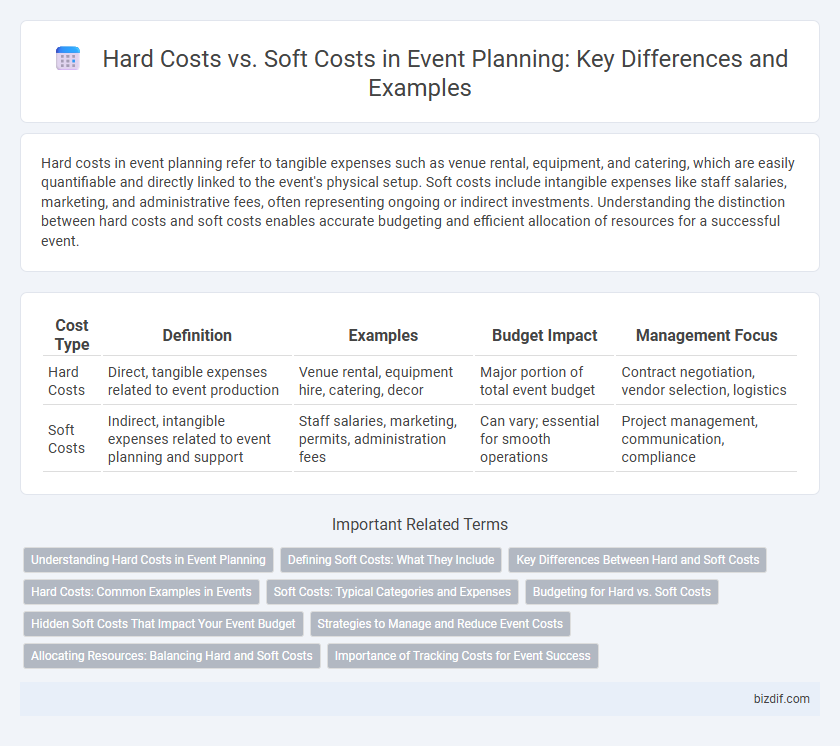Hard costs in event planning refer to tangible expenses such as venue rental, equipment, and catering, which are easily quantifiable and directly linked to the event's physical setup. Soft costs include intangible expenses like staff salaries, marketing, and administrative fees, often representing ongoing or indirect investments. Understanding the distinction between hard costs and soft costs enables accurate budgeting and efficient allocation of resources for a successful event.
Table of Comparison
| Cost Type | Definition | Examples | Budget Impact | Management Focus |
|---|---|---|---|---|
| Hard Costs | Direct, tangible expenses related to event production | Venue rental, equipment hire, catering, decor | Major portion of total event budget | Contract negotiation, vendor selection, logistics |
| Soft Costs | Indirect, intangible expenses related to event planning and support | Staff salaries, marketing, permits, administration fees | Can vary; essential for smooth operations | Project management, communication, compliance |
Understanding Hard Costs in Event Planning
Hard costs in event planning refer to tangible, direct expenses such as venue rental, equipment hire, catering, and audiovisual technology. These costs are typically fixed and easily quantifiable, forming the bulk of the event's budget allocation. Accurate estimation and management of hard costs are crucial for maintaining financial control and ensuring the event's operational needs are met effectively.
Defining Soft Costs: What They Include
Soft costs in event planning encompass non-tangible expenses such as permits, insurance, marketing, and administrative fees that are crucial for project execution but not directly tied to physical materials or labor. These expenses often cover design fees, consultancy charges, and project management overhead. Understanding the distinction between soft costs and hard costs ensures more accurate budgeting and financial control throughout the event planning process.
Key Differences Between Hard and Soft Costs
Hard costs in event planning refer to tangible expenses such as venue rental, equipment, and materials directly needed for the event setup, while soft costs include intangible expenses like marketing, staff salaries, and administrative fees. Hard costs are generally fixed and easier to quantify, whereas soft costs tend to be variable and less visible but equally essential for successful event execution. Understanding the key differences between these costs helps event planners create accurate budgets and optimize resource allocation.
Hard Costs: Common Examples in Events
Hard costs in event planning refer to tangible, direct expenses essential for the event's execution, typically including venue rental fees, audiovisual equipment, catering services, and printed materials such as programs and signage. These costs are usually fixed and easily quantifiable, covering items like stage setup, lighting, furniture rental, and security personnel. Understanding hard costs is crucial for accurate budgeting and resource allocation, ensuring that all physical components of the event are accounted for and financially controlled.
Soft Costs: Typical Categories and Expenses
Soft costs in event planning primarily include expenses related to services and intangible elements such as marketing, permits, insurance, staff wages, and professional fees. These costs cover the planning, design, and management aspects, including consultation fees, event coordination, and promotional activities. Unlike hard costs, which involve physical purchases and rentals, soft costs are essential for ensuring compliance, smooth operation, and effective communication throughout the event lifecycle.
Budgeting for Hard vs. Soft Costs
Budgeting for hard costs in event planning involves allocating funds for tangible expenses such as venue rental, equipment, and catering, which are typically fixed and easily quantifiable. Soft costs encompass intangible or variable expenses like marketing, permits, and administrative fees, often requiring flexible budgeting due to their unpredictable nature. Accurately distinguishing between hard and soft costs ensures efficient resource allocation and prevents budget overruns.
Hidden Soft Costs That Impact Your Event Budget
Hidden soft costs in event planning include staff overtime, last-minute vendor fees, and unexpected technology rentals, all of which can significantly inflate the budget. These expenses are often overlooked during initial budgeting but accumulate quickly, affecting overall profitability. Careful tracking and early identification of soft cost variables ensure better financial control and more accurate event cost forecasting.
Strategies to Manage and Reduce Event Costs
Implementing a detailed budget tracking system helps differentiate hard costs like venue rental, catering, and equipment from soft costs such as marketing, insurance, and staffing fees, enabling precise cost control. Negotiating with vendors for bulk discounts and opting for multipurpose equipment reduces hard costs, while leveraging digital marketing and volunteer staffing minimizes soft costs without compromising event quality. Prioritizing essential expenses and continuously reviewing actual versus projected costs ensures efficient resource allocation and effective overall event cost management.
Allocating Resources: Balancing Hard and Soft Costs
Allocating resources in event planning requires a strategic balance between hard costs, such as venue rental, equipment, and catering, and soft costs including staff wages, marketing, and contingency expenses. Properly forecasting hard costs ensures that tangible needs are met without overspending, while allocating sufficient budget to soft costs enhances event quality and stakeholder engagement. Effective resource distribution optimizes overall event success by maintaining financial control and enhancing experiential value.
Importance of Tracking Costs for Event Success
Tracking both hard costs, such as venue rental and equipment, and soft costs, including labor and marketing, is crucial for accurate budgeting and financial control in event planning. Precise cost monitoring helps prevent overspending and ensures resources are allocated efficiently, directly impacting the event's overall success. Effective cost tracking also enables timely adjustments and improves stakeholder confidence through transparent financial reporting.
Hard costs vs Soft costs Infographic

 bizdif.com
bizdif.com